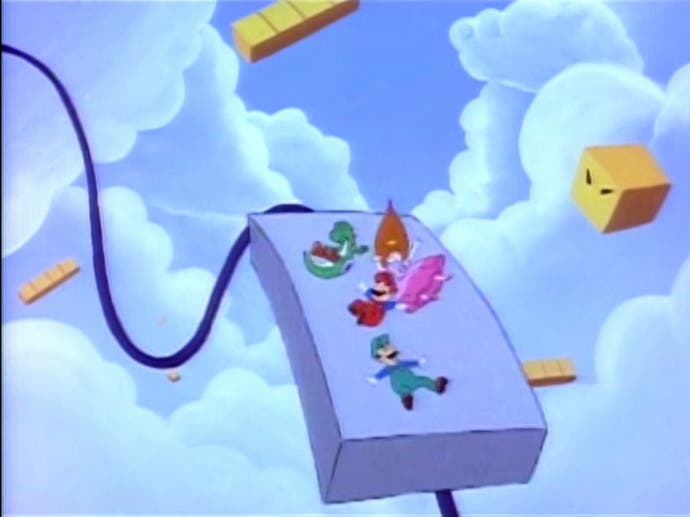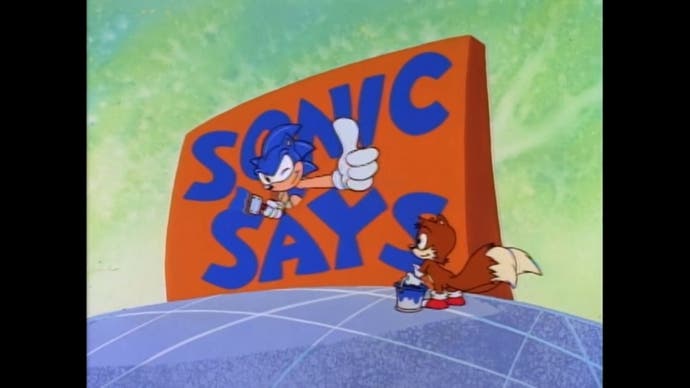When Sonic and Mario dominated children's television
“If you make seven million kids laugh, that must count towards something.”
The Adventures of Sonic was one of the few animated shows that was elevated to the position of being recorded onto VHS tapes in the Ahmed household. It was difficult given both of my siblings were older, but it was possible. My brother, despite also being a gamer back then, found the shows too silly. Eventually, things like Saved by the Bell and Hang Time catering for non-kids would muscle through, ending my relationship with animated shows soon after. (RIP Cardcaptors.)
With the recent releases of new Sonic and Super Mario games, I started to wonder how on earth Sega and Nintendo agreed to licence their golden IP like this. Both mascots were pitted against each other in playgrounds across the globe, even though we all know Sonic is clearly better. Personally, I'm still amazed whenever I notice a Sonic game released on a Nintendo console. So, I agreed to do God's work to find out more, given nobody seems to remember these shows anyway.
"[The production company] DiC was a force at the time," says Phil Harnage, a writer on The Adventures of Sonic as well as all three iterations of Super Mario on television: The Super Mario Bros. Super Show, The Adventures of Super Mario Bros. 3 and also Super Mario World. It sounds strange now to think that one company was involved with both Sonic and Super Mario in any way in the 90s, but Harnage puts that down to DiC's head, Andy Heyward. "He was a savvy businessman and a master salesman," he declares. It's hard to disagree. DiC was behind some of the biggest animation shows of the 80s and 90s, including Inspector Gadget, Alvin and the Chipmunks, Dennis the Menace and Bill & Ted's Excellent Adventures.

Looking back, each iteration of Sonic and Super Mario on TV was noticeably different. The first, The Super Mario Bros. Super Show, had slapstick live-action intro and outro segments with very rigid animation sandwiched in between. Despite a darker tone, both follow-up Mario shows, The Adventures of Super Mario Bros. 3 and Super Mario World were more fun and colourful. By comparison, The Adventures of Sonic is much more playful in spirit.
Reed Shelly was a creator and writer on the Mario and Sonic shows with his father, Bruce Shelly. I ask about this being potential material for an interesting article in itself but Reed remembers it as a great experience. He subsequently summarises with a chuckle, "He put up with me more than I put up with him."
It's hard to capture and articulate the cultural zeitgeist of this time, however many episodes I rewatched for this piece, especially the differences between American and British media. Sometimes the small things like ad breaks featuring Happy Meal toys or a new iteration of Stretch Armstrong were just part and parcel of television, with shows acting as adverts for the latest toys. Apart from game consoles, the only high-tech things around back then were kid-style walkie-talkies. Marketing to kids so directly was the norm, yet there was a serious effort to bring beloved game characters to life at DiC.
Not that it was an easy process. "We sat across desks facing one another working 13 hours a day, through holidays and weekends," Shelly tells me about writing with his father. "We kind of look at one another and...I think we both miss it to be honest. It was a fun time."

Harnage made an attempt to familiarise himself with Super Mario. "I have never been very good at video games, but I did play Mario because the in-house producer was a fanatic and had a Nintendo [console] in his office," he tells me in our lengthy discussion. "Mostly, I would sit and watch him because he was so good, and he would say there's that creature and this other creature you've got to watch out for. He taught me about the world."
This translated well for the various Mario shows. "It was going to be different [from the games] yet it had to have all the familiar touchstones, like the Goombas, the fire plants...if we ever excused something from the game we heard about it, but Nintendo reviewed the scripts and they made sure that everything was good." This is standard procedure for any licensed product, but it's particularly unsurprising given Nintendo's reputation as a very protective entity.
But Harnage says this wasn't always the case. "They were also kind of liberal in letting us do things that had never been in the game and there was no pushback," he says. "I think they liked it when we put Mario in the wild west, in the future and underwater. We would take a familiar fairy tale, legend or something the kids already knew and we would build up an episode around that and make it as fun as possible." (This is perhaps unsurprising given the riffs the games have taken over the years, particularly in a quick-change game like Odyssey.) The creative freedom the writers had also led to things like the famous "Mama Luigi" meme, where a baby Yoshi keeps calling Luigi "mama". The Super Mario shows would usually feature the absurdist outlook that used to be so prominent in double acts like Laurel & Hardy, with Mario and Luigi arguing and helping each other in equal measure.
Of course, I couldn't resist bringing up the spectacu-fail that was the Super Mario Bros. live-action film, and I asked Harnage whether he was contacted about it at the time. "No, and we were all very happy because everybody hated it! It was such a waste of time and talent," he says. That's not to say these animated adaptations weren't aware for the need for talent themselves. "Sonic had one of the popular TV stars at the time as Sonic with Steve Urkel [the character from the hit sitcom Family Matters, played by Jaleel White], so there was a value of using stars at the time," Shelly tells me.
I asked Shelly about whether these shows could be made today, bringing up the irony that new shows have lower viewerships but stronger fandoms, thanks to the internet. "It feels like a time capsule to me," Shelly says. "It's such a different world now and so different for kids. The shows were made for a different era." Does he consider the shows a success? "I think so. We always looked at this and said, if you make seven million kids laugh, that must count towards something. And when I was a little older and doing more pre-school shows, like Teenage Mutant Ninja Turtles, I was a hero at my oldest daughter's pre-school," he adds before tearing into laughter.

Harnage continues to write for TV today, particularly pre-school shows for international outlets. "Because I'm good at it I guess. I must have a very childish, emotional age of four," he laughs, before quickly adding, "I've done more intense kind of things too, like Double Dragon." Over the years he's had multiple Emmy nominations for Fat Albert and Sherlock Holmes in the 22nd Century. Shelly now works at a digital marketing company, but hasn't completely ruled out a return to showbiz. "I'm dabbling in stuff now that would definitely be more on the YouTube side of things," he says, hinting at going full circle and working with his youngest daughter who's interested in entertainment. "I want to make something completely bad on my own," he adds, chuckling once again.
At the end of our conversation I have to bring up the "Sonic Says" segments from The Adventures of Sonic, a helpful PSA moment that's frequently found in many kids' shows past and present, often mandated by the American government or TV networks. "Those were interesting because sometimes they gave me topics that were very hard to deal with," Harnage, who wrote all of them, says. "I remember I got criticised, not by the network but by some Sonic fan that felt I was going too far in having Sonic talk about stranger danger, and not letting anyone touch you or anything like that. I guess it seems jarring seeing that but on the other hand, if you can prevent one kid, then that's fine."
One of the most famous PSAs for kids in Britain involved, coincidentally, hedgehogs crossing the road safely. I ask Shelly about this "Sonic Says" segment too, relaying an anecdote from my time at university when staff at the halls of residence felt obliged to put signs warning students not to microwave anything containing foil. He laughs, before adding, "It still has some value." He reflects on today's fragmentation of media, saying although it has opened doors for new opportunities, "as a society, we have missed a lot as a tribe sharing stuff. Part of that is not having a shared culture."
And how have things have changed with children's TV and gaming over the years? "You know there are still sequels and a lot is based on other material," Shelly says. "I don't think that model changes ever...but there's a lot of innocence lost." This line gave me the nostalgic gut punch I'd been seeking through all this.









